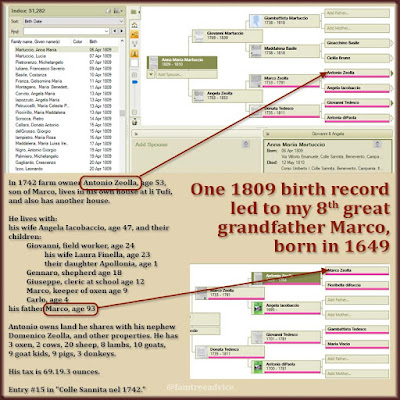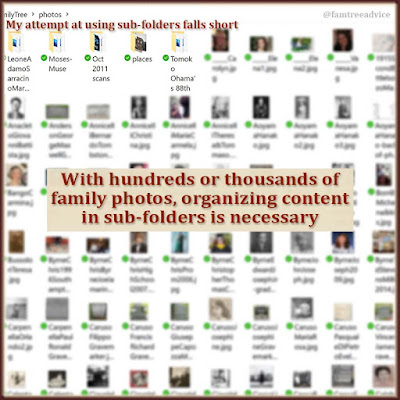A family tree needs a well-made foundation. But unlike other construction projects, your tree needs a solid base at the top.
With a solid foundation, you can add distant relatives like ornaments on a Christmas tree. Imagine if you knew the names of all your 6th great grandparents. Plus all their siblings. And everyone's spouses. Then you could attach younger generations to the right branch as you discover them.
That's what I'm doing with my pet project. I'm piecing together everyone from my grandfather's hometown of Colle Sannita, Italy. I'm lucky. All my ancestors came from a handful of neighboring towns where they lived for centuries. The towns were a bit isolated, so the number of intermarriages is astonishing.
 |
| Researching the earliest birth records can take you back several generations. |
A Foundational Database
In 2017 I downloaded the town's vital records from the Italian website, Antenati. I have more than 38,000 document images arranged in separate folders. There's a unique birth, marriage, and death folder for each year. The years range from 1809–1942 with several gaps. It's a total of 225 folders. (Note that civil record keeping began in 1809 in most Italian towns.)
Next, I made the files easy to use. I renamed each one to include the name(s) of the document's subject(s). Along the way, I realized it'd be helpful to include the name of the subject's father in the file name.
For instance, "007853904_01008 Damiano d'Emilia di Teofilo.jpg" is more useful than "007853904_01008 Damiano d'Emilia.jpg." Why? Because now I can search my computer for every child born to Teofilo d'Emilia.
Two Reasons for This Naming Convention
Reason #1: Keeping the number (007853904_01008) in the file name makes it easy to cite the image's URL. To do this, I keep a special text file in each of the 225 folders. The file contains a template for each image's URL. The template for the folder of 1852 death records says this:
http://dl.antenati.san.beniculturali.it/v/Archivio+di+Stato+di+Benevento/Stato+civile+della+restaurazione/Colleoggi+Colle+Sannita/Morti/1852/636/007853904_00000.jpg.html (01006-01067)
To reconstruct the URL for this exact file, I change the 00000 in the template URL to 01008. Why keep the whole number when I need only the last 5 digits? Because the marriage files, and some other records, come from more than one location. There can be different sets of numbers within a year. The template for 1852 marriages looks like this:
http://dl.antenati.san.beniculturali.it/v/Archivio+di+Stato+di+Benevento/Stato+civile+della+restaurazione/Colleoggi+Colle+Sannita/Matrimoni+pubblicazioni/1852/636/007853904_00000.jpg.html (01086-01147) [These are the marriage banns.]
http://dl.antenati.san.beniculturali.it/v/Archivio+di+Stato+di+Benevento/Stato+civile+della+restaurazione/Colleoggi+Colle+Sannita/Matrimoni+processetti/1852/636/007853904_00000.jpg.html (01148-01502) [These are the birth and death records required for the marriage.]
http://dl.antenati.san.beniculturali.it/v/Archivio+di+Stato+di+Benevento/Stato+civile+della+restaurazione/Colleoggi+Colle+Sannita/Matrimoni/1852/636/007853904_00000.jpg.html (01503-01536) [These are the marriage documents, often with a separate notation for civil and church wedding.]
The beginning of the file number (i.e., 007853904) plus the last 5 digits helps form the exact URL.
Reason #2: I use the Italian word "di" before the father's name in each file name (i.e., Damiano d'Emilia di Teofilo, or Maria Rosa Pilla di Nicola). "Di" means of, and it's a common way to show that someone is the son or daughter of a particular man. Italian records may use the word "fu" (meaning late or deceased). But to simplify my record searching, I use "di" in the file name even if the father is dead.
 |
| Understanding the Antenati URL structure helps you write the source citation. |
Placing the Babies
The renamed vital records are easy to search on my computer. I use a Windows program called Everything, and it's a godsend. My plan is to fit as many babies from the town as possible into my published family tree. What an awesome resource my tree will be for anyone with Colle Sannita ancestry.
Here's the process:
- View the document to find the baby's name, the father's name and age, and the mother's name and age. (Ages are not always included, but you can estimate.)
- Check Family Tree Maker to see if the baby is already in there. If so, prepare the image (crop, enhance, add meta data) and add it to their profile with a source citation for each fact.
- If the baby is not in the family tree, look for the father and mother. See if they're in the tree as husband and wife. If so, add this baby and the document.
- If the baby and parents are not in the tree, search for:
- The marriage of the grown-up baby. If there's a place for their spouse in the family tree, there's now a connection to this baby and their document.
- The death of the mother or father. Their death records should include their parents' names. Check if they are already in the family tree.
- The remarriage of one of the widowed parents. Does their new spouse fit into the tree?
- Siblings for the original baby. One of them may have married someone who's already in the family tree.
That last idea was a game-changer. I revisited a dozen 1809 babies that I couldn't place in my family tree on the first try. Once I tracked down their siblings, I found the connection I needed and worked the whole family into my tree.
Reaching Higher Than the Foundation
The earliest documented babies have parents born around the 1780s or earlier. If I find their death records, I learn the names of their parents, born around the 1750s or earlier. And if I'm lucky enough to find that generation's parents' names, I can check my ultimate reference book. My friend from Colle Sannita, Dr. Fabio Paolucci, published a book detailing every family in Colle Sannita in the year 1742. When I connect someone from the book to my family tree, I can wind up with ancestors born in the 1600s!
If you have Italian ancestors, see if a similar book is available for your town. You won't regret the investment. Use the search box on https://abenapoli.it to look for your ancestral hometown. The book I bought is called "Colle Sannita nel 1742" ("nel" means in the). The book for another of my towns is called "Apice nel 1753." A search for "nel 17" brings up a long list of books detailing the residents of many towns in the 1700s.
This rock-solid foundation will help me place more and more townspeople in my family tree.
I connected all the 1809 babies, and I've already got 31,000+ people in my family tree. Thank goodness I retired last month, because this obsession is an absolute blast!










